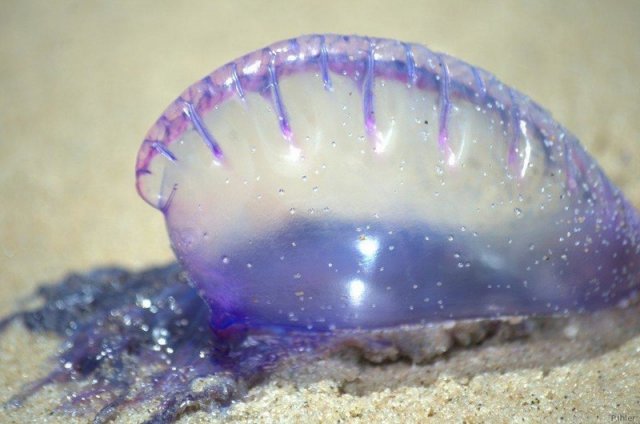
The photo shows us a siphonophore (a gelatinous organism), here a Physalie (Brazilian name Caravela Portuguesa>), which, unlike jellyfish, does not swim but is transported by currents. On the other hand, these organisms are not composed of a single organism but of individual clones specialized in a particular function.
The contact with these organisms is very painful (stinging) and can cause symptoms such as fever, nausea, vomiting, ...
Jellyfish have existed for thousands of years and are part of the Cnidaria, or branch of the Cnidaria, are relatively simple animal species, specific to the aquatic environment (99% marine).
The name comes from the ancient Greek κνιδη &#quot;nettle&#quot;, referring to the characteristic urticating cells of these animals (cnidocytes or cnidoblasts).
They are divided into two classes:
* The Hydroméduses which gathers the autonomous jellyfish which represent the simplest organization with the orders:
Trachymedis (small jellyfish, hemispherical or flattened),
Narcomeduses (jellyfish with more complex organization and umbrella often flattened, lenticular or discoidal),
* The Acalèphes (or Scyphoméduses) which are the most evolved and stinging jellyfish (mostly hemispherical umbrella and well developed musculature) and are generally large and pelagic.
One distinguishes the Charybdisids (extremely stinging jellyfish) or separate order, cubomedos,
- Coronates (jellyfish with the edge of the umbrella cut into lobes at the bottom of which the tentacles are inserted),
- Semeostomes (jellyfish with very stinging tentacles) such as Aurelia aurita or large jellyfish jellyfish, or Pelagia noctiluca (jellyfish with phosphorescent flesh-colored flesh).
- Rhizostomes (the most evolved jellyfish and live in association with symbiotic algae: zooxanthellae).
- Lucernaries (jellyfish become sexed).
The jellyfish are part of the planktonic compartment. They spend their whole life in open water.
They are composed of 97% of water and 3% of dry matter. The movements of the jellyfish are slow and they propel themselves by leaps.
The contact with these organisms is very painful (stinging) and can cause symptoms such as fever, nausea, vomiting, ...
Jellyfish have existed for thousands of years and are part of the Cnidaria, or branch of the Cnidaria, are relatively simple animal species, specific to the aquatic environment (99% marine).
The name comes from the ancient Greek κνιδη &#quot;nettle&#quot;, referring to the characteristic urticating cells of these animals (cnidocytes or cnidoblasts).
They are divided into two classes:
* The Hydroméduses which gathers the autonomous jellyfish which represent the simplest organization with the orders:
Trachymedis (small jellyfish, hemispherical or flattened),
Narcomeduses (jellyfish with more complex organization and umbrella often flattened, lenticular or discoidal),
* The Acalèphes (or Scyphoméduses) which are the most evolved and stinging jellyfish (mostly hemispherical umbrella and well developed musculature) and are generally large and pelagic.
One distinguishes the Charybdisids (extremely stinging jellyfish) or separate order, cubomedos,
- Coronates (jellyfish with the edge of the umbrella cut into lobes at the bottom of which the tentacles are inserted),
- Semeostomes (jellyfish with very stinging tentacles) such as Aurelia aurita or large jellyfish jellyfish, or Pelagia noctiluca (jellyfish with phosphorescent flesh-colored flesh).
- Rhizostomes (the most evolved jellyfish and live in association with symbiotic algae: zooxanthellae).
- Lucernaries (jellyfish become sexed).
The jellyfish are part of the planktonic compartment. They spend their whole life in open water.
They are composed of 97% of water and 3% of dry matter. The movements of the jellyfish are slow and they propel themselves by leaps.


